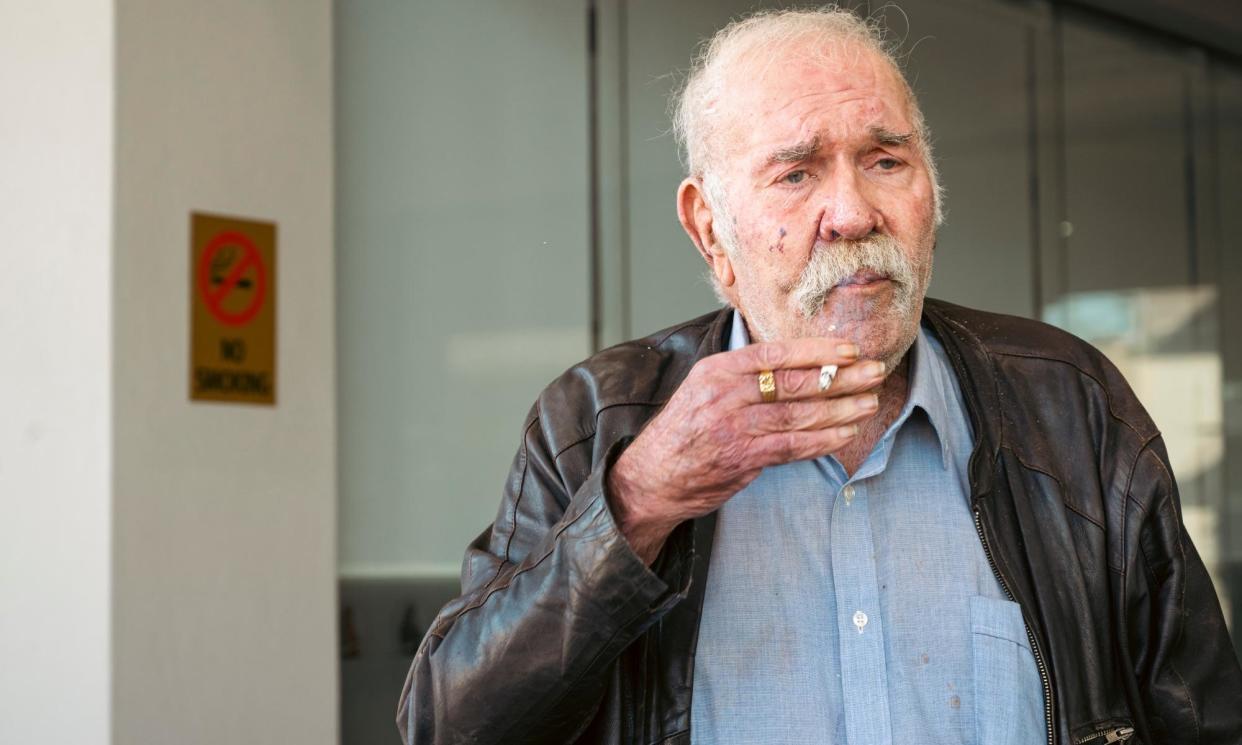‘Ta-ta and farewell’: wisecracks and tears as Brisbane sends Jack Karlson off to ‘succulent Chinese meal’ in the sky

When, on Monday afternoon, an 82-year-old man was buried in a cemetery on Brisbane’s south-western suburbs, one of the three burning questions for those not in the know was: which name would mark his final resting place?
Would it be the name he was given at birth: Cecil George Edwards?
Would it be the name by which he was known during his stints in Australia’s most notorious prisons, from Brisbane’s Boggo Road to Sydney’s Long Bay to Melbourne’s Pentridge Prison: The Hun?
Would it be any of the various aliases he adopted on the run from the law: Chick Edwards, Jack Edward Menchau, Helmet Markson, Peter Alan Marsh or George A Reece?
Would it be the secret name – revealed until now only as John X – under which he had been going in recent years from his hideaway home in the hilly scrub between Gatton and Esk west of Brisbane?
Or would it be the name under which he shot into modern Australian folklore with the video of his arrest in 1991 while eating a “succulent Chinese meal” in a Fortitude Valley restaurant in which he delivered what must rank as one of the great pieces of improvised guerrilla theatre of our times: Jack Karlson?
The second question: would any of the phrases he bellowed bombastically in his 80 seconds of fame – now etched into the modern Australian vernacular – be enshrined above the resting place of his earthly remains?
The obvious contenders were, of course, those most signature lines: “Gentleman, this is democracy manifest!” or: “What is the charge? Eating a meal? A succulent Chinese meal?”
Related: A succulent Chinese meme: the real story behind Australia’s most bombastic arrest
But dark horse contenders might also be his initial response – delivered with regal indignation – to a detective informing him he is under arrest (“I’m under what?”) or his cheery, parting words before being manhandled into a Ford Falcon by three uniformed police officers and two detectives: “Ta-ta and farewell!”
The answer to both those questions will have to wait, as Karlson’s family are yet to decide. But early indications are the old crook will, as always, have a surprise in store.
His memorial service in Sumner – a quick dash through bush away from the Brisbane Correctional Centre at Wacol – was held to remember the life of “John Christopher Midson, a.k.a Jack Karlson, a.k.a Cecil George Edwards”.
Who was this Midson character?
“It’s a long story,” film-maker Heath Davis, who is shooting a documentary on Karlson, said.
While the epitaph in the order of service, below a painting of Karlson’s infamous arrest done by the brush of the man himself, read: “Just keep laughing. Tata and farewell. Love you all.”
The third question was: who would emerge on that hot, sunny day at the end of winter to mark the passing of this enigma of a man?
Carnage, the book by journalist and historian Mark Dapin from which much of the information in this article and many others will and have been drawn, charts Karlson’s connections to some of the darkest figures in Australia’s modern history, as well as a barely credible assortment of immensely talented playwrights and painters.
Karlson had a long association with Christopher Dale Flannery, a man known as Mr-Rent-a-Kill and Australia’s most notorious hitman – Dapin believes Flannery might have shot Karlson through the leg.
He also had a tragic association with Barry Quinn, the psychopathic convicted killer known as “Australia’s Charles Manson, whose trail of carnage included the murder of Karlson’s wife, Ivanka Karlson.
As well, Karlson shared a cell and a deep bond with celebrated playwright and armed robber Jim McNeil and had a connection to the painter Charles Billich, whose works have hung at the White House, the UN headquarters and the Vatican, and some of whose backgrounds Karlson claimed to have started.
The first of those three are dead now and the fourth did not appear, but what of the other 80 or so people paying their farewells to Karlson?
Among an old crim or two, hard men who had lived tough lives, was the delicate Astrid Dahl – a painter who tutored Karlson in Pentridge decades ago – the restaurateur of the China Sea and a retired police officer who plucked Karlson from its succulent meals.
But front and centre, full of smiles and tears and wisecracks, was Karlson’s family.
“Rest in peace Daddy Cool,” his daughter Heidi said.
“He certainly put on a good show,” niece Kim said, revealing Karlson’s favourite Keno numbers and yet another “alias”: Uncle Cheque.
“That’s what we knew him as,” she said. “This afternoon we shall have a flutter for Uncle.
“Rest in peace Uncle and keep laughing.”
Then, to Kenny Rogers’ The Gambler and beneath a photo in which his arms are spread wide as if in prayer, he wears a poncho, clutches a beer and has a sombrero haloing his head like a religious icon, Karlson’s family carried away his coffin, the question of the words and name on his plaque, like so much of his life, still shrouded in mystery.


